Welcome back ye land lubbers. When we last left off I was speaking in general terms about my love of the sea and the boats and subs that inhabit it. What makes the sea so great is how much it can change. One minute it's calm and smooth like a sheet of glass, the next it's 70 foot waves and a dark tempest that could snatch away grow men like leaves in a strong wind. But just under the surface the ocean remains calm. Quite and interesting dynamic. Today we'll take a look at this mysterious world under the sea to some history-defining games. A good number of these titles are older than you, some are older than me but I've played almost all of them in the arcade or console as the case may be.
You can break down a sea adventure into one of three types, those with a submarine, those with an underwater personal watercraft and those based on the surface of the ocean. I won't talk about the third because few are adventure games and most are boat or jet ski racing games like Wave Race or Hydro Thunder. Those you should already be familiar with. The first two sea adventure genres have had a few sleeper hits in their time. I'll highlight the submarine ones today.
The submarine genre is one of the few that can claim to have a deep-rooted arcade legacy. One of the earliest electronic games was Sega's Periscope, released in 1968 and Midway's Sea Raider released in 1969. The gimmick for many of the submarine games has been a reliance on the periscope, a form of control unique to actual submarines.

Unlike traditional arcade screen where everyone could see what you were playing, gamers on sub games could peer into their own screen which displayed a CRT or mini LCD. The player had the firing buttons at the thumbs of the periscope handle with some crosshairs on the display to help target enemies. While this gimmick worked in arcades for over 30 years it was not always the most popular format for players.
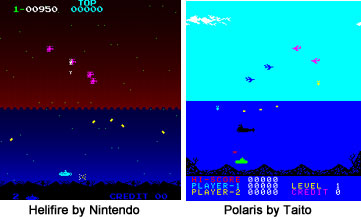
It didn't take too long for companies to begin applying the SHUMP (or shmups) formula to the submarine genre. While the flying ship in most SHUMPS can only fire forward the submarine was unique because it could fire torpedoes forward and missiles straight up. This allowed developers to come up with games that could be played like Space Invaders but with attackers from the side as well. Early adopters of this format included Midway's Submarine in 79, Taito's Polaris in 1980 and Helifire by Nintendo also in 1980. But it wasn't until 1981 when the side-scrolling aspect of the SHUMP was also applied to the submarine game.
The Battle of Atlantis by Comsoft featured colorful underwater environments where ships and sharks would attack you. Amenip's Mariner game (aka 800 Fathoms) also came out in 1981. This game expanded on the the themes of exploration and diverse locations through which you had to pilot your sub while also taking on advancing enemies. While not as memorable as their sky and space contemporaries, the submarine SHUMP would survive for decades.
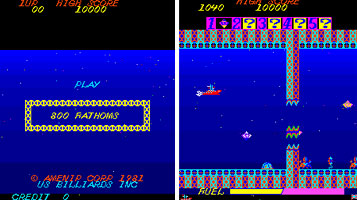
A fast-paced arcade FPS shooter using the periscope was released by Taito in 1989. It was called Battle Shark and was probably better remembered for having a main character that looked just like Charles Bronson.
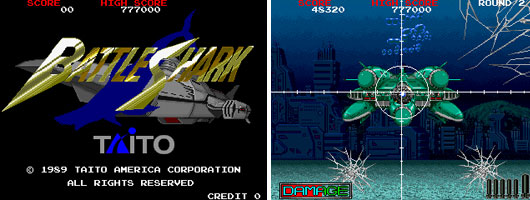
The designs in Battle Shark were all great, plenty of sci-fi subs battling it out over sunken cities. The only sticking point was the periscope. It was large and clumsy, it also felt dated. So the remaining classic sub games were all played with traiditonal joystick or game pad. The best of the early console adopters was Submarine Attack, released in 1990 by Sega for the Master System. It was a throwback to the classic arcade SHUMP and had a quiet following.
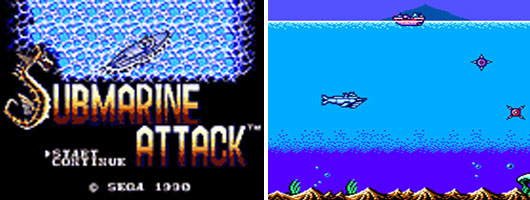
Over the next few years we would see all sorts of attack sub games for the Genesis, PC and Nintendo. Some console titles based on popular movies like the Hunt for Red October. One of the more original titles from recent years featured a mini sub that controlled like a combat fighter. The series was called Aquanox and it was set in the near-future so the tech was semi-believable. Plus it was a nice change of pace to be fighting in underwater cities rather than storming through the clouds or off in space.
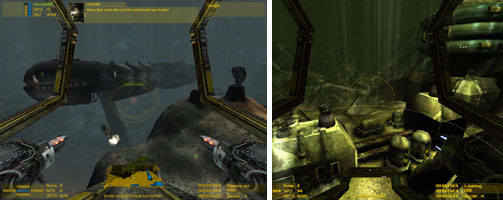
Of all the submarine SHUMPS ever made, my favorite by far has to be Irem's 1993 sleeper-hit In the Hunt aka Kaitei Daisensou. This game should look and feel very familiar to fans of the Metal Slug series because it was made by the same people.
Here is where I have to make an aside as to what makes In the Hunt and Metal Slug such a classic. It goes back to 1990, before the Irem and SNK designers joined forces and founded Nazca to develop the Metal Slug series. Most SHUMP developers are looking for a hook, a gimmick to make their game memorable. It's hard to come up with something memorable when Japan cranks out so many SHUMPS year after year. In some cases it is the design of the ship and enemies that stick with fans. The large grotesque monsters and falcon-like hero ship featured in R-Type helped put Irem on the map. Other developers rely on cartoony, anime-inspired designs with soft bubbly graphics like Cotton by Success.
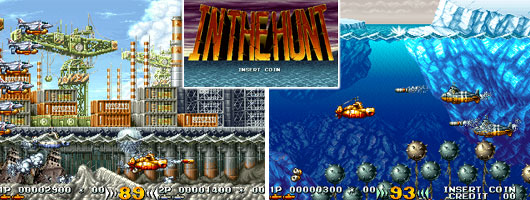
The people at Irem had been experimenting with a fusion of hyper-realistic designs and cartoon-like animation. The "style" that they were working on began to gel in the early 90's. Air Duel was a SHUMP that featured traditional air combat with hundreds of enemies and gigantic bosses, what set the visuals apart was the highly-detailed graphics on every plane and even in the backgrounds. The attention to detail was nothing short of maddening. For the next game they took this level of detail and then threw it in a blender with an artistic style that can only be called genius.
In the Hunt was the first title that Irem made featuring the fantastic, over-the-top vehicles and levels that eventually made Metal Slug so great. All of the obscene detail was in the game, every billboard, car, truck, railroad tie and sewer could be counted individually. On some levels if you looked closely you could even make out pedestrians running for their lives, they could not have been more than a few pixels in height! This unique style of presentation, superb animation combined with the classic submarine SHUMP formula and fantastic bosses made In the Hunt the best sub game ever made. Fans would clamor for a sequel but Irem had other plans.
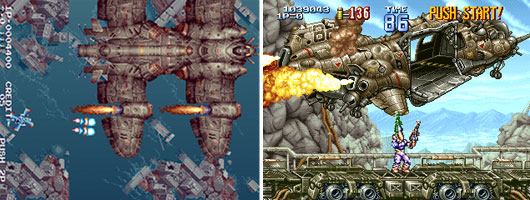
They took the stylized world featured in Air Duel and In the Hunt and applied them to a side-scrolling run and gun game in 94. The game is better known as Gun Force II / Geo Storm. While the designers still hadn't made the main characters completely cartoony, nobody can deny that the template for Metal Slug had been created between those two titles.
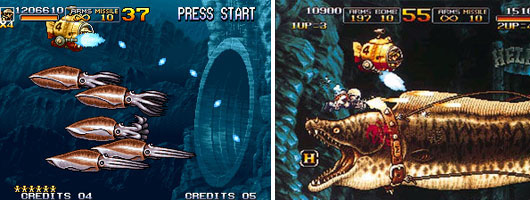
I am not a super fan of Metal Slug but I do like the designs. My favorite Metal Slug level takes place in Metal Slug 3 because it is the only time we are introduced to the Metal Sub, a nod to In the Hunt. What you might not notice is that the Metal Sub and scale of Metal Slug is much smaller than that of In the Hunt. The sprites featured in both games are relatively the same size, however proportionally they are different. The sub in In the Hunt is about five times bigger than the Metal Sub. It would be great if the next Metal Slug game could begin incorporating more scale in their series so that if a player jumped into a larger tank or a larger plane then the camera would pan back and allow us to see more of the world like In the Hunt. Of course even if the camera pans back you would still keep the same level of detail that Nazca is famous for.
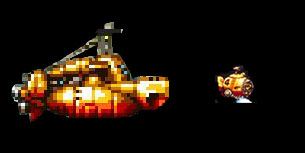
But that is just me thinking out loud again. Making a sprite-based game is a lost art and it seems that nobody has the dedication to keep the format alive. If Nazca wanted to have a complete meltdown then they would take my advice and feature a scalable world with infinite detail. They wouldn't get far before running out of time and money, but damn would it be a pretty game.
Let's end this aside and finish with In the Hunt is the best submarine SHUMP ever made. I hope that you have played it and if not go track down a copy online or in the arcade. You won't be sorry! If you think my blog on underwater-based videogames is over then you don't know me very well! Tune in tomorrow for the final part of this series.
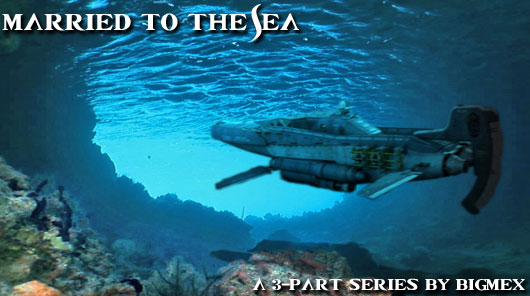
As always if you would like to sponsor me please visit my Patreon page and consider donating each month, even as little as $1 would help make better blogs and even podcasts!

No comments:
Post a Comment